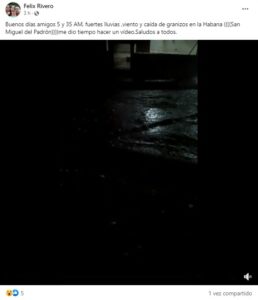MADRID, Spain.- Several municipalities of the Cuban capital woke up this Thursday with heavy rain and hail.
“A severe local storm affected Havana shortly after 5:00 in the morning. In Casablanca, gusts of winds of up to 60 kilometers per hour and hail fall were reported at 5:15 in the morning. Twitter the Cuban Institute of Meteorology (INSMET).
It formed late in the morning in the Straits of Florida, advanced south and affected Havana late in the morning.
Weather Forecast Center, INSMET.
A strong severe local storm occurs with abundant hail in Havana shortly after 5:15 in the morning, with abundant hail larger than a chickpea. #ElTiempoEnCuba @InsmetC— Forecast Center, Insmet (@cnp_insmet_cuba) April 20, 2023
This weather situation was reported in East Havana, Plaza de la Revolución, Centro Habana, Old Havana, San Miguel del Padrón, Diez de Octubre and Guanabacoa.
Numerous users shared images of the hail fall. According to INSMET, some of these pieces of ice were “larger than a chickpea”.
For his part, Univisión23 meteorologist Javier Serrano accurate that the hailstones reached more than two inches.
The size of the hailstones this morning in Havana reaches more than two inches. #Hail #Havana #Cuba #TimeWatchers #ElTiempoUnivision pic.twitter.com/g8fc7J1M9l
— Javier Serrano (@JavierSerrano) April 20, 2023
“A tremendous experience, it seemed that they were throwing stones at the house at 5:30 am. It was an extraordinary hailstorm,” said the netizen. Braulio Mendoza by sharing a video of the rain.
“Good morning friends. 5:35 am, heavy rain, wind and hail fall in San Miguel del Padrón, Havana. I had time to make a video,” he said. Felix Rivero.
Hail is a type of solid precipitation that is made up of irregular balls or clumps of ice, each of which is referred to as a hailstone. It is made up mainly of water ice.
The formation of hail originates with the presence of a solid particle. This is dragged by strong ascending winds within the cloud, to which water particles are attached. When ascending, the cooling of these particles occurs, freezing them.

















